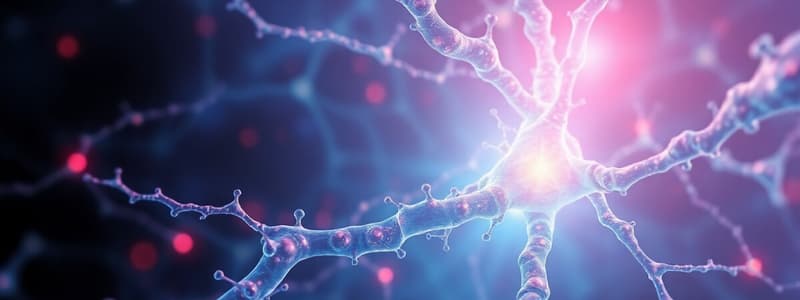Podcast
Questions and Answers
What is the primary function of fibroblasts in connective tissue?
What is the primary function of fibroblasts in connective tissue?
- Serve as immune cells defending against pathogens
- Synthesize protein fibers and intercellular substances (correct)
- Provide electrical signals for muscle contraction
- Transport nutrients to other cells
What characteristic shape do fibroblasts typically exhibit?
What characteristic shape do fibroblasts typically exhibit?
- Cuboidal
- Flattened and irregular
- Columnar
- Spindle or fusiform (correct)
In what way are fibroblasts classified in connective tissue?
In what way are fibroblasts classified in connective tissue?
- Mobile cells that migrate throughout the body
- Cells that undergo rapid division and change shape
- Fixated cells that remain within the tissue (correct)
- Transitional cells that adapt to varying conditions
What is a distinguishing feature of fibroblasts compared to white blood cells?
What is a distinguishing feature of fibroblasts compared to white blood cells?
What role do the cytoplasmic processes of fibroblasts play?
What role do the cytoplasmic processes of fibroblasts play?
What type of connective tissue is most commonly associated with fibroblasts?
What type of connective tissue is most commonly associated with fibroblasts?
Flashcards
Fibroblast function
Fibroblast function
Fibroblasts produce protein fibers and intercellular substances for connective tissue.
Fibroblast shape
Fibroblast shape
Fibroblasts are flat, elongated, spindle-shaped cells with processes at each end.
Fibroblast location
Fibroblast location
Fibroblasts are the most common cells in all connective tissues.
Fibroblasts vs. white blood cells
Fibroblasts vs. white blood cells
Signup and view all the flashcards
Connective tissue fibers
Connective tissue fibers
Signup and view all the flashcards
Fixed cell
Fixed cell
Signup and view all the flashcards
Study Notes
Connective Tissue Cells
- Fibroblasts are the most common cell type in all connective tissues.
- Fibroblasts are spindle-shaped or fusiform in shape.
- Fibroblasts form connective tissue fibers and intercellular substance.
- Fibroblasts synthesize protein fibers and intercellular substances to support connective tissue.
- Fibroblasts are considered fixed cells, meaning they don't move to other locations within the body.
Fibroblast Structure and Function
- Fibroblasts are flat, elongated cells.
- They have cytoplasmic processes at each end.
- They are found within loose connective tissue.
- Fibroblasts are responsible for making the fibers and the substance between the tissue components
- Different subpopulations of fibroblasts are possible within the tissue.
Studying That Suits You
Use AI to generate personalized quizzes and flashcards to suit your learning preferences.




